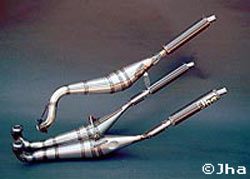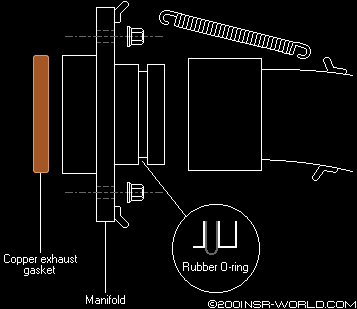
The stock exhaust system seriously hampers the NS400's potential! With a displacement of 387cc and a top speed of 130mph, the bike is no slouch, but it is out of its rivals (RD500 and RG500 Gamma) league! The exhaust system's 'tuned length' has been seriously compromised by the need for ground clearance under the chain side, and Honda's solution to this was simply to shorten the pipes until they fitted, and then attempt to regain the power-band by fitting the ATAC system. The cost of this compromising is a motor that peaks at just 9800rpm!
It is impractical to tune any aspect of the standard exhaust system, so a complete replacement system is required.
Terry Shepherd Tuning in the UK and Jha in Japan both supply such a system for 2 alternative budgets! Jha's system, as pictured, is stainless steel and includes all three chambers with carbon end cans, Terry Shepherd Tuning's system comes in the form of a kit for self assembly, but is dramatically cheaper than the Jha option!
ATAC.

Both systems do away with the ATAC. This early, largely ineffective attempt at a power-valve, was designed by Honda to reclaim low-end power and really is lost on the NS400! It does work, but its general ineffectiveness is demonstrated by Honda's exclusion of it on the top cylinder!!
Terry Shepherd Tuning's kit includes all sections of the system including headers and alloy stubs to fit to the cylinders in place of the ATAC. The pipes are of a 'cross-over' configuration, regaining the lost 'tuned length' of the standard system but retaining superior ground clearance over stock! The top chamber doesn't suffer the compromising of the lower two, so the stock item is retained. The kit is therefore only supplied with an alloy end can matching the design of the two lower pipes, and this substantially reduces its cost.
The 'kit' pipes allow the engine to 'rev out' to 11000rpm and gives top speeds in the 140-145mph area*. With the scrapped ATAC system and the new race pipes, you can also expect a considerable weight saving too.
*Performance figures should be extremely similar with the Jha system.
Terry Shepherd Tuning's kit is currently priced at UK£332 + shipping + VAT (where applicable).
| Note: | Although each system can be very similar in design and purpose, each will require the jetting optimised to suit. It is of paramount importance that the jetting is revised after installation. |
Carbon and alloy end cans are also available from Swarbrick Racing for the NS400R.
Fitting the system.
Most aftermarket exhaust systems now come with separate manifolds and spring clips to hold the various sections together. Bear this in mind if you are modifying your bike in steps, for example, if you intend to buy end cans only, with a view to fitting a system at a later date, check that the system you are buying can be used with your bolt on cans! Below is a diagram of a typical aftermarket manifold and its associated components.

When fitting the new manifolds always use new gaskets and remember that the rubber O-rings, if used, will need replacing every couple of months as they rapidly deteriorate with the heat generated by the engine and exhaust gases. Replacement O-rings can be bought from any good hydraulic hose specialist at a fraction of the cost rather than going to the exhaust manufacturer, check in the Yellow pages for a list of local suppliers. Pirtek in the UK supply excellent replacements for only a fraction of the cost of the OEM parts!
Benefits of spring clips holding the sections together are ease of assembly and disassembly, and that GP style look! The chambers are also easily removed for periodically checking the RC Valve adjustment. The down side is that the clips are notorious for "buzzing" when the motor is revved, and that they can quite often mysteriously disappear overnight!!
Aftermarket motocross systems use spring clips to hold them on so a visit to your local MX shop will be the order of the day soon after you've acquired your new system. Apico make a very good cheaper alternative to the supplied springs (part# spring 90mm!) and as they are mild steel instead of stainless steel, can be both fitted (stretched) more easily and have their ends crimped to help prevent themselves working loose again. Since using these springs on our manifolds we have yet to loose one!
HRC systems come complete with rubber shields similar to that on the side stand (kickstand) spring to stop the aforementioned "buzzing", a good alternative is a length of heatshrink on each spring or simply a short length of electrical tape wound around them, although the heatshrink is definitely tidier and will last longer although not indefinitely!! Another good tip is to lockwire the sections together. This provides added security just in case those springs do work loose 100 miles away from home! (It also stops some bright spark running off with your end cans when you're not looking!)
Special thanks to Terry Shepherd for permission to use
his information and company name in
this section.
Title image reproduced by kind permission of Jha.
